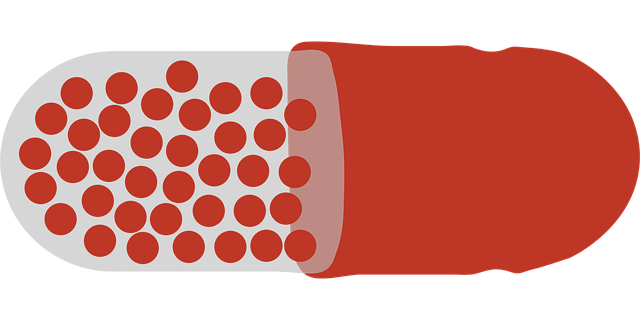GLP-1 drugs, mimicking gut hormone effects, revolutionize Type 2 diabetes management by controlling blood sugar and promoting weight loss. Their unique mechanism improves glycemic control and offers cardiovascular benefits. Personalized medicine leverages genetics and lifestyle for tailored treatments, enhancing adherence and outcomes. Future developments aim to increase convenience and effectiveness with longer-acting drugs and technology integration.
“The landscape of Type 2 diabetes management has been significantly transformed by GLP-1 drugs, a class of innovative treatments that have emerged as powerful tools in blood sugar control. This article delves into the remarkable advancements and future prospects of GLP-1 agonist treatments. From their pivotal role in unlocking complex diabetes management to exploring therapeutic potential beyond insulin, we unravel the evolution, mechanisms, and impact of these drugs. By examining efficacy, safety, and delivery methods, we provide insights into how GLP-1 drugs are revolutionizing patient care.”
Unlocking Type 2 Diabetes Management: GLP-1 Drugs' Role

Type 2 diabetes management has seen a significant shift with the emergence of GLP-1 drugs. These innovative treatments have revolutionized the way healthcare professionals approach this chronic condition, offering a more nuanced and effective solution compared to traditional methods. By mimicking the effects of the natural hormone GLP-1, these drugs play a crucial role in improving blood sugar control and enhancing overall metabolic health.
The primary advantage lies in their ability to stimulate insulin production and suppress glucagon release, leading to better glycemic management. Moreover, GLP-1 drugs have shown promising results in weight loss, providing a dual benefit for patients. This two-pronged approach not only improves diabetes symptoms but also reduces the risk of long-term complications, making it an increasingly popular choice in modern diabetes care regimens.
Beyond Insulin: Exploring GLP-1's Therapeutic Potential

GLP-1 agonists, a class of drugs that mimic the effects of the gut hormone glucagon-like peptide-1 (GLP-1), have revolutionized diabetes management. While insulin has long been the cornerstone of treating type 2 diabetes, GLP-1 drugs offer a unique and versatile approach. These drugs not only lower blood sugar levels but also provide additional benefits like weight loss and improved cardiovascular health.
Beyond their insulin-like actions, GLP-1 agonists have shown promise in various therapeutic areas. They can reduce appetite, leading to better control of calorie intake and weight management. Additionally, some GLP-1 drugs are being explored for non-diabetic conditions, such as obesity and heart disease. This versatility makes GLP-1 drugs a game-changer in personalized medicine, offering tailored treatments for different metabolic disorders.
The Evolution of GLP-1 Agonists: From Discovery to Approval

The journey of GLP-1 agonist treatments began with the discovery of glucagon-like peptide-1 (GLP-1), an incretin hormone produced in the gut. This natural compound sparked interest for its role in regulating blood sugar and stimulating insulin secretion. Over time, scientists developed synthetic GLP-1 drugs that mimic this hormone’s actions, leading to a new class of diabetes medications.
The evolution from discovery to approval was marked by extensive research and clinical trials. Early preclinical studies laid the foundation, showcasing the potential benefits of GLP-1 in managing blood glucose levels. Subsequent clinical trials demonstrated the safety and efficacy of these drugs, paving the way for regulatory approval. Today, various GLP-1 drugs are available, offering significant advancements in diabetes treatment, including improved glycemic control and reduced weight gain compared to traditional insulin therapies.
Targeting the Intestine: Mechanisms of GLP-1 Drug Action

One of the key aspects of GLP-1 agonist treatments is their unique mechanism of action, which primarily targets the intestine. These drugs mimic the effects of the natural hormone glucagon-like peptide-1 (GLP-1), produced by L cells in the gut in response to food intake. By activating GLP-1 receptors, they stimulate insulin secretion from pancreatic beta cells in a glucose-dependent manner, helping to lower blood sugar levels.
Moreover, GLP-1 drugs have additional intestinal effects that contribute to their overall efficacy. They slow gastric emptying, reducing the rate at which food is absorbed and causing a feeling of fullness, which aids in weight management. Additionally, these drugs stimulate the growth and differentiation of intestinal cells, potentially improving gut health and barrier function. These multifaceted mechanisms make GLP-1 drugs powerful tools in managing diabetes and promoting overall metabolic health.
Enhancing Blood Sugar Control: Efficacy and Safety Studies

GLP-1 agonist treatments have emerged as a powerful tool in enhancing blood sugar control, particularly for individuals with type 2 diabetes. These innovative GLP-1 drugs mimic the effects of natural gut hormones, promoting insulin secretion and reducing glucagon release in a glucose-dependent manner. Extensive efficacy and safety studies have demonstrated their superior performance compared to traditional antidiabetic medications.
Clinical trials have shown that GLP-1 agonists significantly lower HbA1c levels, reduce body weight, and improve overall metabolic control. Moreover, these treatments have been well-tolerated, with minimal adverse effects, making them a safe and effective option for diabetes management. The positive outcomes have led to increased prescribing of GLP-1 drugs, offering hope for improved glycemic control and quality of life for patients with type 2 diabetes.
Injectable vs. Oral: Delivery Methods Revolutionized

The way GLP-1 (glucagon-like peptide-1) agonist treatments are delivered has seen a remarkable evolution, with a shift from injectable to oral administration methods. This change is a significant innovation in diabetes management, offering patients more convenience and improved adherence to their medication regimens. Traditionally, GLP-1 drugs required injections, which could be a barrier for many patients due to fear of needles or the hassle of frequent injections. However, the development of oral GLP-1 agonists has revolutionized this aspect, making it easier for individuals with diabetes to incorporate their medication into their daily routines.
Oral delivery methods provide several advantages, including increased patient comfort and improved adherence. These drugs are designed to be absorbed through the gastrointestinal tract, mimicking the natural actions of GLP-1 in the body. As a result, patients no longer need to worry about regular injections, leading to better quality of life and potentially improved long-term health outcomes. This shift in delivery methods has made GLP-1 agonist treatments more accessible and user-friendly, contributing to their growing popularity in diabetes management.
Combating Complications: Reducing Cardiovascular Risks

One of the significant benefits of GLP-1 agonist treatments is their potential to reduce cardiovascular risks, a critical aspect often associated with diabetes management. These innovative GLP-1 drugs have shown promising results in clinical trials by lowering blood pressure and improving lipid profiles, thereby mitigating some of the key risk factors for heart disease. By mimicking the effects of natural gut hormones, these medications can help combat hypertension and hyperlipidemia, which are significant contributors to cardiovascular complications.
Additionally, GLP-1 agonists have demonstrated the ability to prevent or delay the progression of diabetic nephropathy, a complication that increases the risk of cardiovascular events. This dual benefit of managing blood sugar levels and reducing cardiovascular risks makes GLP-1 drugs an attractive option in diabetes treatment, offering a comprehensive approach to patient care.
Personalized Medicine: Tailoring GLP-1 Therapy for Individuals

Personalized medicine is transforming the landscape of healthcare, and this approach is increasingly applied to GLP-1 agonist treatments. By tailoring therapy to individual patients, healthcare providers can optimize glucose control while minimizing side effects. This involves considering various factors such as a patient’s genetic makeup, metabolic profile, and lifestyle. For example, certain GLP-1 drugs may be more effective for individuals with specific genetic variants affecting drug metabolism or insulin response.
Moreover, personalized medicine enables the adjustment of GLP-1 therapy doses based on an individual’s response, ensuring a more precise and safe treatment regimen. This tailored approach has the potential to enhance patient adherence and outcomes, as it addresses the unique needs and characteristics of each person. As research continues to unravel the complexities of diabetes and its treatment, personalized medicine is poised to play a pivotal role in improving the lives of those managed with GLP-1 drugs.
Future Prospects: Research Trends and Next-Gen Treatments

The future of GLP-1 agonist treatments looks promising, with ongoing research focusing on enhancing efficacy and improving patient convenience. One trend is the development of longer-acting GLP-1 drugs, aiming to mimic the natural rhythm of insulin secretion more closely. This could lead to once-weekly or even once-monthly administrations, simplifying treatment adherence. Additionally, researchers are exploring ways to personalize GLP-1 therapies based on individual patient needs and metabolic profiles.
Next-generation treatments may incorporate combinatorial approaches, pairing GLP-1 agonists with other diabetes medications to achieve better glycemic control. The integration of technology, such as wearable sensors and digital health platforms, could enable continuous monitoring and real-time adjustments to GLP-1 drug regimens. These innovations have the potential to significantly impact diabetes management, improving patient quality of life and reducing the burden of chronic disease care.
